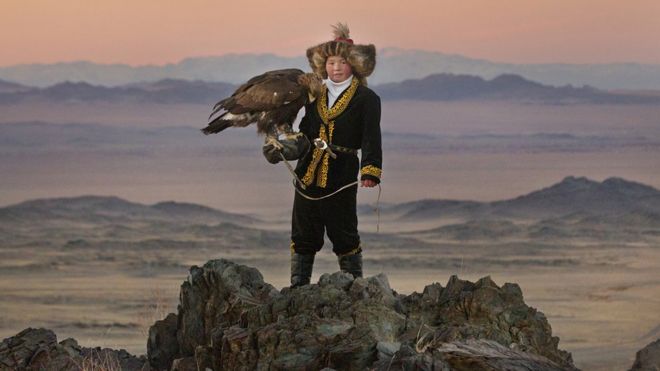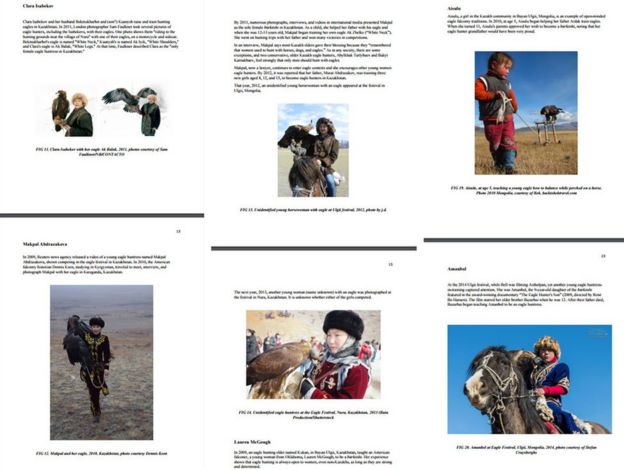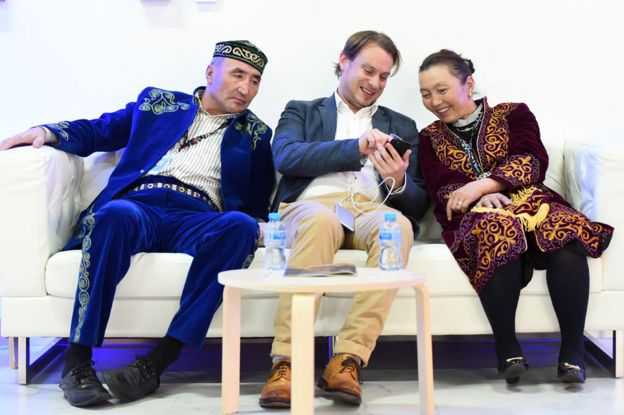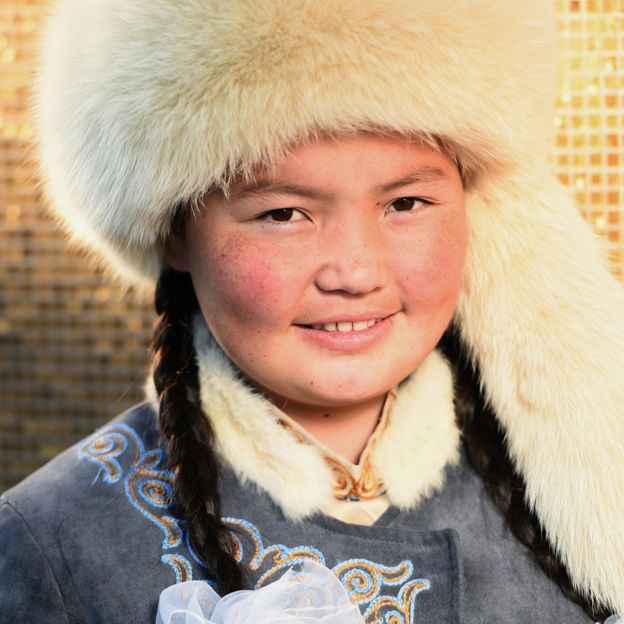Is the Eagle Huntress really a documentary?
- 6 February 2017
- Magazine
 ASHER SVIDENSKY
ASHER SVIDENSKY
The Eagle Huntress, a documentary about a Kazakh nomad girl in Mongolia learning to hunt with a golden eagle, divides opinion. It is up for a Bafta award on Sunday night but missed out on an Oscar nomination, possibly because to some viewers it feels staged. Director Otto Bell, however, denies all accusations that the film was scripted, acted or re-enacted.
The story of the Eagle Huntress is simple and heartwarming. Aisholpan Nurgaiv, the rosy-cheeked 13-year-old heroine, is trained by her father to hunt on horseback with a golden eagle - traditionally a male pursuit - and shocks everyone by winning the prestigious eagle-hunters' competition held annually in the town of Ulgii, in north-western Mongolia.
It has a stirring musical soundtrack, ends with an anthem "You can do anything" sung by pop superstar Sia, and is narrated by another teenage role model, Star Wars actress Daisy Ridley.
One reviewer has described it as a "fairytale documentary" - two words that don't usually go together - that feels at times "more like fiction than fact".
Another calls it a "repetitious, half-baked, contrived and crudely staged homily on female empowerment [that] tells us less about Kazakh nomads than Pocahontas does about the Algonquins in 17th Century Virginia". The film took another culture's traditions, he goes on, and translated them "into the tired platitudes of a second-rate Disney animation".
Early publicity for the film did little to inspire confidence, by stating that Aisholpan had fought "an ingrained culture of misogyny to become the first female eagle hunter in 2,000 years of male-dominated history" - a claim that US historian Adrienne Mayor has shown is untrue.
This line was recast to say that Aisholpan is "the first female in 12 generations of her Kazakh family" to be an eagle huntress. But Mayor and others still argue that the film creates a false impression, by failing to mention other Kazakh eagle huntresses, and exaggerating the patriarchal pressures that Aisholpan had to overcome.
"I think eagle hunting would be open to any young woman who would want to pursue it," Mayor says.

The spark for the film came when director Otto Bell came across photographs of Aisholpan taken by Israeli photographer Asher Svidensky on the BBC News website, in April 2014.
He tracked Aisholpan's family down (being nomads, they move around) and on the very first day, he says, filmed one of the early scenes in the film, where the girl and her father seize a baby eaglet from its nest. It's a dramatic moment with Aisholpan climbing down a cliff, her father holding a rope attached to her waist. And it's one of a number of scenes that some critics have assumed was staged.
Otto Bell rejects this.
"The scene where she takes the baby eagle out of the nest - people are always surprised to know that's one single take. I filmed it like I would film a live sports event," he says.
"I did it drawing on my experience in commercials. As far as reconstructing stuff and staging stuff, what you see on the screen is what we got."
Another scene that sceptics find questionable comes when Aisholpan's father, Agalai, gets his own father to give his blessing to Aisholpan's eagle-hunting ambitions. The shot is framed and the camera is rolling when the conversation between the two men takes place outside the tent, and the girl is summoned to receive the old man's good wishes.
Was it staged? No, says Bell.
"The blessing scene - he said he was going to do this, I just asked him to do it outside. He told me: 'We need to think about what my father thinks of this.' The father likes to sit outside anyway, he likes to watch the goats. That was as close [to staging] as we got."
 GETTY IMAGES
GETTY IMAGES
There are other moments that critics grumble about. Tim Robey in the Telegraph describes as "woefully unspontaneous" a scene where a newsreader on the radio in the family's tent is heard talking about the forthcoming eagle festival, and Aisholpan pipes up to plead with her parents for permission to enter.
It's "engineered storytelling" he says. "You feel sorry for her enacting some of these charades."
Will Dunn in the New Statesman is also bothered by the film's "re-enactment and editorialising", though he notes that without the imposed girl-power narrative it's "a film about the fox-hunting techniques of Mongolian Kazakhs, a subject that is not exactly a banker at the box office". He also accepts it would have been a shame if Aisholpan's world had not been revealed to a wider audience.
Nigel Andrews in his review in the Financial Times last December wrote that the action and dialogue seemed "a little set up". He was particularly suspicious of a montage of grumpy elderly men filmed tut-tutting over the idea of a woman taking up eagle hunting. But while the academic Adrienne Mayor suggests Bell went searching for these naysayers in Kazakhstan and Kyrgyzstan, in Andrews' latest article about the film Bell says he just went round knocking on elders' doors, and all openly voiced disapproval. So he put them in the film.
Meghan Fitz-James, a Canadian traveller who spent time with Aisholpan's family, also says that one scene showing Aisholpan training for the eagle festival was in fact shot three days later, in a four-hour shoot with coaching and retakes.
 ASHER SVIDENSKY
ASHER SVIDENSKY
But the fundamentals of the film are confirmed by Aisholpan herself.
"I started to train when I was 10 years old, going into the mountains with my dad," she told the BBC, while passing through Ulan Bator recently. "I told my dad that I wanted to become an eagle huntress."
That was in 2011 - two or three years before Svidensky arrived on the scene - and she wasn't just training with the eagle, she was already hunting too, she says.
Aisholpan also confirms that she was aware some men thought a girl was not strong enough to hold an eagle, that she should stay at home, and would not be able to stand the cold hunting for hours in winter in the Altai mountains.
"The pressure gave me more will and power. It gave me the inspiration to win," she says.
But the curmudgeonly views of these mostly elderly men were not expressed at the eagle festival, where officials and competitors were supportive, she says. After her win in 2014 (captured on film) she was greeted by loud cheers when she competed again in 2015 and 2016.
Watching the film, a cynical viewer may fear that Aisholpan has been coached when she says: "Girls can do anything if they try." But she says the same thing off-screen too: "I am happy that I have won a man's competition. It shows how strong women are."
 GETTY IMAGES
GETTY IMAGES
Who would not be proud, in her position, to have beaten grown men with years of eagle-hunting experience? Any telling of her story would carry a female empowerment message, even if this film does milk it for all its worth.
Despite her criticisms of the film, the historian Adrienne Mayor agrees that Aisholpan is a worthy heroine.
"Her bravery and her feats in that eagle hunting contest are really amazing and inspiring," she says. "That would have been enough in the film."
Additional reporting by Grace Brown in Ulan Bator, and Mike Wendling in London

ไม่มีความคิดเห็น:
แสดงความคิดเห็น